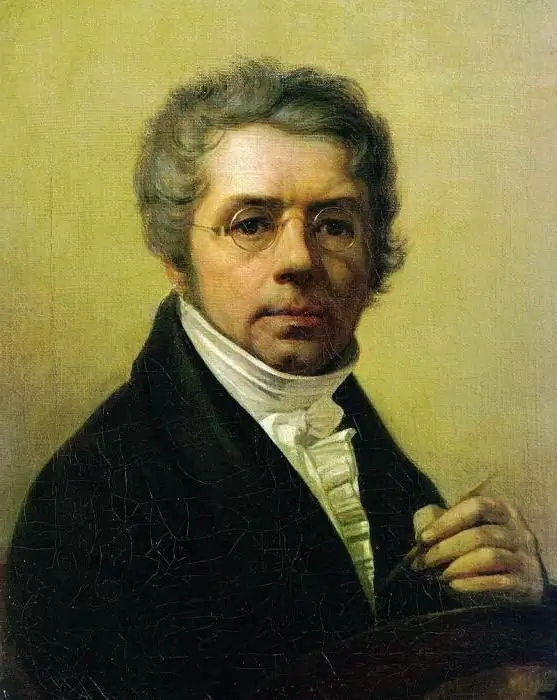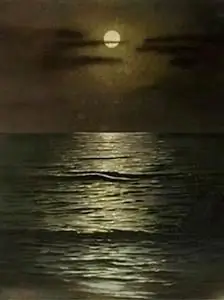2025 Author: Leah Sherlock | [email protected]. Last modified: 2025-01-24 17:46:30
How is the work of a Russian artist with a sonorous surname Venetsianov most often defined? Paintings depicting genre scenes from peasant life are called the beginning of the domestic genre in painting, a phenomenon that would eventually flourish in the era of the Wanderers.

But the magnitude of Venetsianov's artistic talent, the scale of his human personality had a huge impact on the development of Russian fine arts not only within the framework of one genre direction. This becomes especially noticeable when looking closely at his canvases.
"Portrait of Mother" (1802)
Aleksey Gavrilovich Venetsianov was born in 1780 into a Moscow merchant family with ancestors from Greece. In Russia, they received the nickname Veneziano, later converted into a Russian surname. When Alexei became interested in drawing, his studies did not seem like something serious to his parents. Perhaps that is why he did not receive a regular art education. It is believed that he received the first knowledge about the technique of painting from the "uncle" -educator, and the main source of art education that Venetsianov received is the paintings of old masters in museums and the creations of modern painters in salons and galleries.
The main genre in Russian painting of that time was a portrait, therefore the first painting experience of Venetsianov known to us belongs to this genre. This is a portrait of the mother - Anna Lukinichna, nee Kalashnikova.

It is noticeable how the twenty-two-year-old youth still lacks painting skills, how difficult it is for him to convey volume, air and light. But something else is also visible - his ability to convey different textures of fabric, sufficient confidence in the drawing. And most importantly, he managed to convey the feelings of his model: some embarrassment and tension of the mother from her unusual role and his tender attitude towards her.
Self Portrait (1811)
After 1802, Venetsianov moved to St. Petersburg, where he tried to make a name for himself and start earning a living through painting. Soon he was forced to enter the service of a minor official in the postal office. A happy chance allowed him to meet the famous portrait painter V. L. Borovikovsky (1757-1825), who highly appreciated the paintings of Venetsianov and became his mentor both in the profession and in life. Perhaps due to his influence, Venetsianov petitioned the Academy of Arts for the official title of painter. According to the charter of the Academy, the applicant had to submit his work. To this end, Venetsianov paints a self-portrait.
In this picture is already visiblehigh level of technical skill of the artist. This is an accurate and truthful work of a true realist, devoid of romantic touch and embellishment. The psychological depth of the image created by the artist was also highly appreciated. Here, and attentive focus on work, and a clearly felt sense of dignity.
Venetsianov was defined by the Council of the Academy of Arts as "appointed" - one of the formal qualification levels of the artist, which made it possible to obtain the title of academician after completing the task assigned by the Council. Venetsianov becomes an academician after painting a given portrait of K. I. Golovachevsky.
"The Barn" (1821)
Shortly after receiving the title of academician of painting, Venetsianov unexpectedly leaves the capital and service and settles in his estate Safonkovo in the Tver province. Here he creates his most significant works, dedicated to the poeticization of peasant life.

Before starting work on the painting “The Barn”, the artist ordered his serfs to dismantle the front wall in a large barn where grain was stored. He set himself the task of conveying a linear perspective and depth, similar to those that struck him in the paintings of the French painter Francois Granet. In addition to the image of the room going into the distance, surprising for that time, the carefully adjusted composition of the figures of peasants and animals frozen in various poses impresses. They are full of ancient significance and amazing poetry.
The painting was highly appreciated by Emperor Alexander I, who bought itfrom the artist, also giving the author a ring with a diamond. This made his financial situation a little easier.
"On the arable land. Spring” (1820s)
Many paintings by Alexei Gavrilovich Venetsianov are full of secrets and mysteries that are still beyond the control of professionals and amateurs of painting. Such is a small canvas (65 x 51 cm) with an almost Botticelli title and a poetic sound commensurate with the greatest masterpieces of the Renaissance. It is believed that this painting is part of a cycle dedicated to the seasons.

The scene of peasant labor appears as an action full of sacred, cosmic meaning. The figure of a young woman who went to hard work, wearing her best clothes, a child on the edge of the field, making the plot look like an icon of the Mother of God, the mirror figure of another peasant woman leaving in the depths - everything is full of mysteries. The landscape is filled with significance and great simplicity, against which these ordinary and at the same time majestic events take place. Alexey Venetsianov, whose paintings are difficult to attribute to a particular genre, is considered one of the founders of the Russian poetic landscape.
Reapers (1820s)
But the main genre for Venetsianov is the portrait, and the main task he solves is the expression of genuine interest and respect for those he portrays. High pictorial skill, combined with laconicism and sophistication of the composition, enhances the impression that Venetsianov has on the viewer. Pictures, the description of the content of which can fit into a few phrases, amaze with depth andversatility, even if their heroes are simple peasants.

On the hand of the reaper, who stopped for a minute to rest, two butterflies sat down. A boy looks at them over his shoulder, mesmerized by their beauty. The artist painted almost a snag - it seems that now the light wings will flutter and disappear in the summer heat. The main characters are just as real - their faces, hands, clothes. The feelings expressed by the young woman and the child also seem real, and most importantly, you can feel how Venetsianov admires them.
Morning of the Landlady (1823)
The role of Venetsianov as the founder of genre diversity in Russian painting is undeniable. One of the first he tried to draw attention to the special beauty of Russian nature, paving the way for future brilliant landscape painters - Levitan, Shishkin, Kuindzhi, Savrasov. In the portrait, he showed completely unusual main characters - people from the people. But the poeticization of the everyday genre was a particularly innovative phenomenon.

It is believed that the master made his wife Marfa Afanasyevna and her serf girls the heroines of his painting. This explains the warm feeling that permeates this canvas. There is no confrontation between the hostess and her forced servants - it is more like a family scene in which the girls have their own dignity and calm beauty. The surroundings play an equally important role in the picture: the lovingly painted filling of the interior and - what is especially striking - the soft, but all-filling light.
Zakharka (1825)
Peasant children are frequent characters in portraits and genre paintings that Venetsianov painted. The paintings “The Sleeping Shepherd”, “That’s the Father’s Dinner”, “The Shepherd with a Horn” depict children not as disembodied cherubs from icons and classical paintings - they are full-fledged heroes with their own character, experiencing strong emotions that are part of the harmony of our world. Such is Zakharka, the protagonist of Venetsianov's painting. With the names and descriptions of such works of the artist, it becomes clear his vocation as a teacher, which left its mark on Russian painting.

He thought about the fate of talented children born as serfs when he saw a yard boy trying to draw something with chalk on a blackboard. Soon the “Venetsianov school” was born from this. In addition to teaching the skills of the profession of an artist, he gave shelter to peasant children, fed and watered them, and tried to redeem many of them to freedom. Among the students of Venetsianov are the brilliant Grigory Soroka and about 70 artists, many of whom graduated from the Moscow Academy of Arts. The activities of the school proceeded in the face of opposition from official academicians, who did not honor Venetsianov with the title of teacher of painting.
"In the harvest. Summer” (182?)
His life cannot be called carefree, it has always been filled with work and trouble. Its end was also tragic and unexpected - Alexei Gavrilovich died in 1847, when the horses harnessed to his wagon suddenly got scared and carried away, and he, trying to stop them, fell onto the road.

Man on earth,the harmony of his relationship with nature, with the whole world around him is the main theme of the artist Venetsianov, the main essence and value of his heritage, something for which his name is revered by connoisseurs and lovers of Russian painting. The painting depicting a reaper against the backdrop of a recognizable Russian landscape, which at the same time has cosmic significance, is one of the pinnacles of the great Russian painter's work.
Recommended:
Paintings of socialist realism: features of painting, artists, names of paintings and a gallery of the best

The term "socialist realism" appeared in 1934 at the congress of writers after the report made by M. Gorky. At first, the concept was reflected in the charter of Soviet writers. It was vague and indistinct, described the ideological education based on the spirit of socialism, outlined the basic rules for displaying life in a revolutionary way. At first, the term was applied only to literature, but then spread to the whole culture in general and the visual arts in particular
Perov Vasily Grigorievich: paintings, their names and descriptions

Vasily Grigorievich Perov (1834-1882) - the great Russian artist-itinerant. During his lifetime, he was recognized as one of the best representatives of everyday realistic and historical painting, an outstanding portrait master. In the article we will consider the most famous paintings by Perov Vasily Grigorievich with names, we will give a brief description of each of them
The most famous painting by Alexei Gavrilovich Venetsianov: title, description. Paintings by Venetsianov

A. G. Venetsianov (1780 - 1847) - an artist of the Russian school, who studied with V.L. Borovikovsky and received the title of academician, when in 1811 he completed the competitive program - “Portrait of K.I. Golovachevsky"
Adolf Hitler: paintings with names, photos of Hitler's paintings

It is known that Hitler was fascinated by photographs, but he was even more interested in painting. His vocation was the fine arts. Adolf madly loved to draw
Pre-Raphaelite paintings with names. Themes of Pre-Raphaelite paintings

From the 1850s, a new direction in poetry and painting began to develop in England. It was called "Pre-Raphaelites". This article presents the main ideas of the artistic community, the themes of creative activity, Pre-Raphaelite paintings with names

